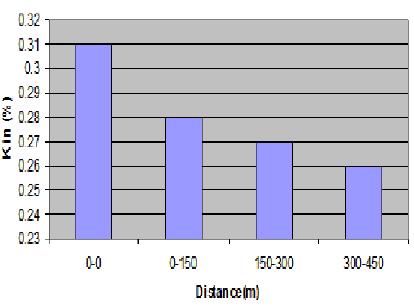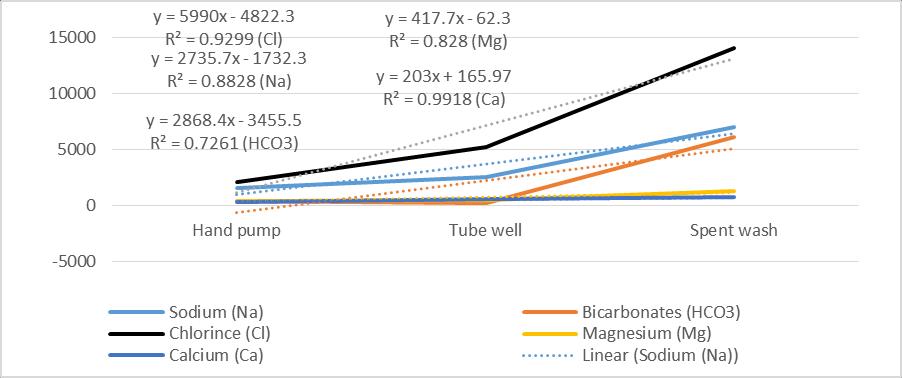
2 minute read
SAR [30
from Effect of Distillery Spent-wash on Channel Bed and Groundwater Quality: Case Study of Unicol Distill
Fig.6: Available phosphorus in soil (%) at various distances from the spent wash channel bed
Available K in soil (%)
Advertisement
Potassium (K) is another element that required in the soil essentially for plant growth and development. The available K was determined at the experimental site at the 0-15, 15-30 and 30-45 cm soil depths to see the effect of spent wash channel bed on the soil available K at adjacent area. The data (Figure 7) showed that the available K was higher (0.49%) in the surface soil (0-15 cm), and declined to 0.22 and 0.14 percent at 15-30 and 30-45 cm soil depths, respectively. The effect of spent wash on soil available K indicated that at the channel bed, the available K was highest (0.31%), while available K showed a concurrent decrease to 0.28, 0.27 and 0.26% with increasing distance from channel bed to 150, 300 and 450 meters, respectively. The highest overall available K (0.53%) was noted at channel bed in surface soil; while the lowest available K (0.13%) was determined at 300 meters distance from channel bed in sub-surface soil (15-30 cm). Statistically, the differences in available K at various soil depths as well as the effect of spent wash channel bed at different distances were significant (P<0.05). However, similarity (P>0.05) in available K was observed between 300 and 450 meters distances from channel bed.

Fig.7: Available potassium in soil (%) at various distances from the spent wash channel bed
Comparative analysis of groundwater and spent wash
The groundwater samples were collected from two sources (tube well and hand pump) and their physical and chemical properties were compared with the spent wash samples collected from the channel bed.
Sodium (Na) BOD, COD and pH removal
The regression analsyis for reedgrass plant height v/s effulent quality suggested that 56.63% variation in BOD (r2 = 0.5663), 51.32% variation in COD (r2 = 0.5132) and 67.49% change in pH (r2 = 0.6749) was guided by the change in the reed grass plant height.
The sodium (Na) concentration in groundwater samples collected from different sources was determined and compared with spent wash. The data (Figure 8) showed that the lowest Na concentration (1578.7 ppm) was determined in groundwater samples collected from hand pumps; and the Na concentration in tube well water was 2588.3 ppm; while the highest Na concentration (7050 ppm) was determined in spent wash. The above figure for Na concentrations in analysed liquid showed a highly significant difference and clearly indicated that the Na concentration in spent wash samples is manifold higher than the tube well and hand pump water samples.


Fig.8: Groundwater analysis for Na (ppm) obtained from different water sources as compared to spent wash channel bed






